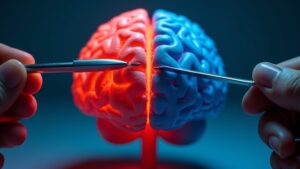Double dissociation assists researchers comprehend how diverse brain regions govern particular behaviors through examining patients with inverse shortcomings. Provided that one individual battles with memory yet has standard language, while another displays the converse pattern, it implies these functions depend on distinct brain systems. This technique unveils obscured connections between brain damage and behavior, offering hints about how the mind organizes tasks. The findings challenge presumptions, demonstrating that even closely associated capabilities can function autonomously. What appears like a simple breakdown frequently uncovers deeper realities about the brain’s architecture.
Foundations of Double Dissociation
Though the brain functions as a whole, some operations work autonomously—like specialized tools in a toolbox. The modularity of mind theory suggests these functions can be selectively impaired by brain damage, revealing distinct brain-behavior relationships.
Double dissociation helps uncover these separations through comparing two patients with opposite impairments. For example, one could struggle with memory but not language, while another shows the reverse pattern. This method, developed in the mid-20th century, proves certain cognitive processes rely on different brain regions.
Via studying attention, memory, or language this way, researchers confirm how damage affects one ability while sparing another. These findings highlight the brain’s intricate organization, where even minor injuries can disrupt specific functions without touching others.
Key Theoretical Principles Behind Double Dissociation
Several core ideas form the backbone of double dissociation, helping scientists study how different brain areas control separate mental skills. The method relies on showing that damage to one brain region impairs a specific cognitive function while leaving another intact, and vice versa.
This reveals the independence of cognitive processes, supporting the modularity of mind theory—the idea that the brain operates through specialized, interconnected modules. With comparing patients with distinct brain lesions, researchers confirm that certain mental abilities rely on separate neural pathways.
Double dissociation strengthens the argument for localized brain functions, showing how damage in one area doesn’t universally disrupt all cognition. This principle has reshaped cognitive neuropsychology, clarifying how brain and behavior intertwine through precise, observable patterns.
Classic Examples in Psychological and Neurological Research
Broca’s and Wernicke’s aphasia highlight how brain damage can disrupt speech production or comprehension separately, showing distinct language pathways.
Similarly, face and object recognition studies reveal cases where patients lose the ability to recognize faces but still identify objects, or vice versa. These classic examples help clarify how specific brain regions control different cognitive functions.
Broca Vs Wernicke’s Aphasia
Two of the most well-studied language disorders in neuroscience, Broca’s and Wernicke’s aphasia, reveal how damage to specific brain regions can drastically alter speech and grasp. The double dissociation between these conditions highlights the modular nature of brain function—damage to Broca’s area (left inferior frontal gyrus) disrupts speech production, leaving comprehension intact, while Wernicke’s area (left superior temporal gyrus) damage impairs insight, despite fluent speech.
Broca’s aphasia causes slow, effortful speech with missing grammar, whereas Wernicke’s aphasia leads to nonsensical, rapid sentences. This contrast underscores how brain and behavior are intricately linked, mapping distinct roles to separate regions. Patients with Broca’s aphasia often apprehend their struggles, while those with Wernicke’s might not recognize their errors, reflecting the depth of neural specialization in language processing.
Face Vs Object Recognition
The study of face versus object recognition reveals a clear double dissociation in cognitive neuropsychology. Patients with prosopagnosia struggle to identify faces but recognize objects normally, while those with visual agnosia show the opposite pattern. This separation highlights how brain organization divides these functions.
The fusiform face area specializes in processing faces, while object recognition involves a broader network in the ventral visual stream. Developmental research suggests faces are prioritized initially, possibly due to innate wiring. Proficiency, like training, can blur these distinctions, showing flexibility in the system. These findings support modular theories, emphasizing how distinct brain regions handle specific tasks. Such insights deepen comprehension of visual processing and its breakdowns in disorders.
Comparing Single and Double Dissociation in Cognitive Studies
Comprehending how brain damage impacts different mental skills requires comparing single and double dissociation, two methods that reveal how cognitive functions rely on distinct brain regions. In cognitive neuroscience, single dissociation shows one impaired function while another remains intact, suggesting a possible link. Double dissociation, however, provides stronger evidence through demonstrating two patients with opposite impairments, proving the functions are independent.
| Feature | Single Dissociation | Double Dissociation |
|---|---|---|
| Evidence Strength | Moderate | Strong |
| Function Link | Suggests dependency | Confirms independence |
| Patient Groups | One | Two |
| Neural Inference | Limited | Clear |
Single dissociation may hint at vulnerability, while double dissociation verifies separate brain pathways. Both methods help untangle the brain’s complex wiring.
Methodological Approaches and Neuropsychological Assessments
Grasping how brain injuries impact thinking abilities regularly hinges on methods like double dissociation, which demonstrates how diverse mental capacities function autonomously. This approach isolates cognitive functions by showing two patients with opposite deficits—like one struggling with speech but comprehending words, while another speaks fluently but can’t fathom.
Neuropsychological assessments using double dissociation reveal brain-behavior relationships, helping pinpoint which regions control specific tasks.
- Modular Brain Organization: Studies show tasks like memory or language rely on distinct brain areas.
- Classic Examples: Broca’s aphasia (speech loss) vs. Wernicke’s (comprehension loss) highlight independent systems.
- Research Applications: Attention, memory, and perception are tested to map cognitive independence.
- Limitations & Advances: Confounding factors exist, but modern neuroimaging refines interpretations.
These methods clarify how damage affects thinking, offering a clearer perception of brain function.
Clinical Applications and Diagnostic Value
How can doctors determine which part of the brain is damaged whenever a patient struggles with speech but understands words, or speaks fluently yet can’t grasp meaning? Double dissociation helps clarify these brain-behavior relationships through showing how specific tasks rely on distinct brain regions. Clinicians use this method to pinpoint lesions, diagnose disorders like aphasia or agnosia, and tailor rehabilitation strategies. Via comparing performance on two tasks—such as speaking versus comprehension—doctors identify which cognitive functions remain intact and which are impaired, guiding treatment decisions.
| Condition | Double Dissociation Pattern |
|---|---|
| Broca’s aphasia | Impaired speech, intact comprehension |
| Wernicke’s aphasia | Fluent speech, poor comprehension |
| Prosopagnosia | Can’t recognize faces, can name objects |
| Amnesia | Lost episodic memory, spared skills |
| Visual agnosia | Sees objects, can’t identify them |
This approach elevates diagnostic precision, improving the outcome for patients.
Limitations and Controversies in Interpretation
- Not fully independent: Brain regions often handle multiple functions, blurring clear separations.
- Competing theories: Distributed models suggest functions rely on interconnected networks, not isolated areas.
- Confounding factors: Harder tasks could obscure true dissociations, complicating interpretations.
- Test limitations: Differences in performance could stem from how tests are designed, not brain damage alone.
Advances in Neuroimaging and Computational Modeling
Recent breakthroughs in neuroimaging and computational modeling have opened new doors for grasping of how the brain handles different tasks. Functional MRI now maps cognitive functions with precision, revealing how brain regions work independently—key for apprehension of double dissociation.
Computational modeling, like neural networks, simulates these complex patterns, testing theories without relying only on patient cases. Multivariate pattern analysis digs deeper, showing subtle brain activity differences missed by older methods.
Together, neuroimaging techniques and computational modeling help illustrate why some skills break apart after injury while others stay intact. Tracking brain changes over time also clarifies how damage alters function. These tools make it easier to see why certain tasks rely on separate brain systems, solving puzzles that once confused researchers.
Future Directions in Studying Brain-Behavior Relationships
The progress in neuroimaging and computational modeling has set the stage for even deeper exploration into how the brain shapes behavior. Future research will likely focus on refining these tools to uncover clearer links between brain networks and specific cognitive functions. Through integrating double dissociation findings with advanced techniques, scientists can better isolate how distinct brain regions contribute to behavior.
Network neuroscience will help map how interconnected brain systems work together or independently. Computational modeling can simulate brain processes, anticipating how damage or changes affect behavior. Combining lesion studies with real-time imaging may reveal how injuries disrupt cognitive functions. Longitudinal tracking of patients could show how brain-behavior relationships evolve over time.
These approaches promise a clearer representation of the brain’s role in behavior, bridging gaps between theory and real-world observations.
Conclusion
Research advances brain comprehension, refines diagnostic tools, and deepens cognitive insights. Double dissociation reveals neural specializations, supports modular theories, and drives clinical applications. Future studies will integrate innovations, expand neuropsychological knowledge, and bridge theory with practice. This methodology enriches science, informs treatments, and unravels brain-behavior mysteries.





